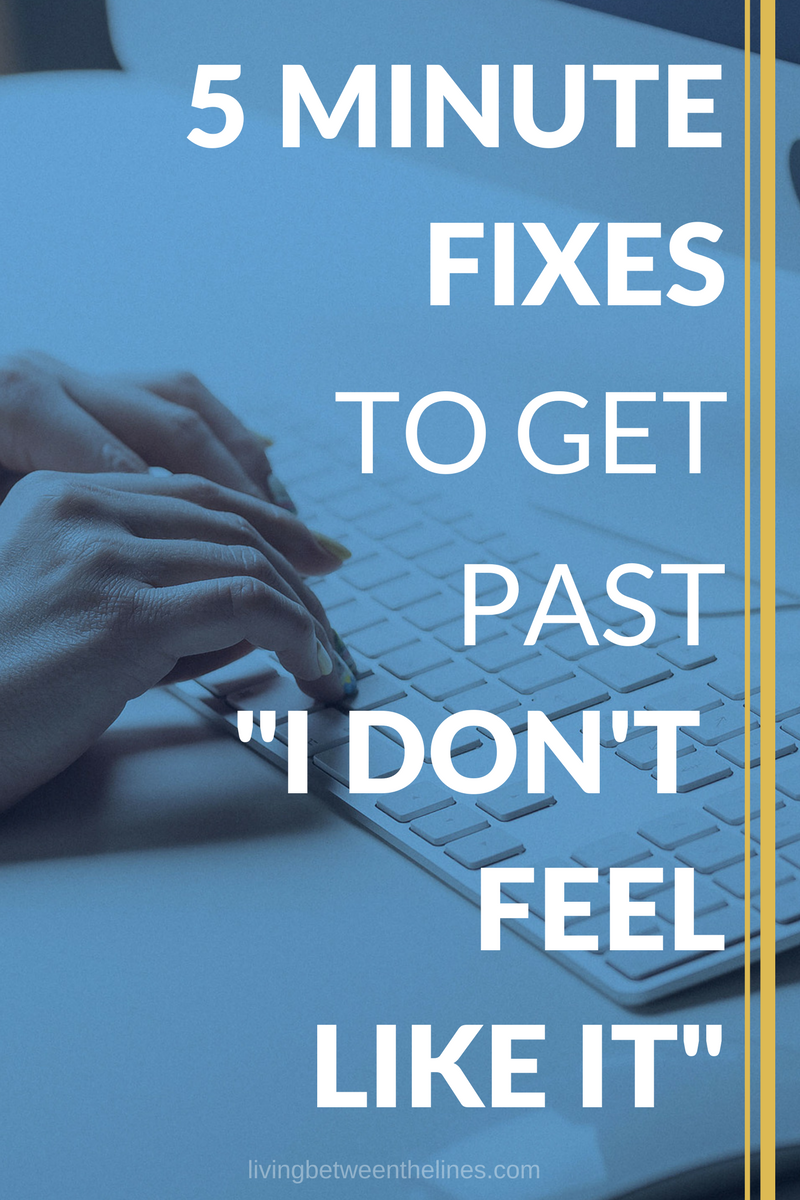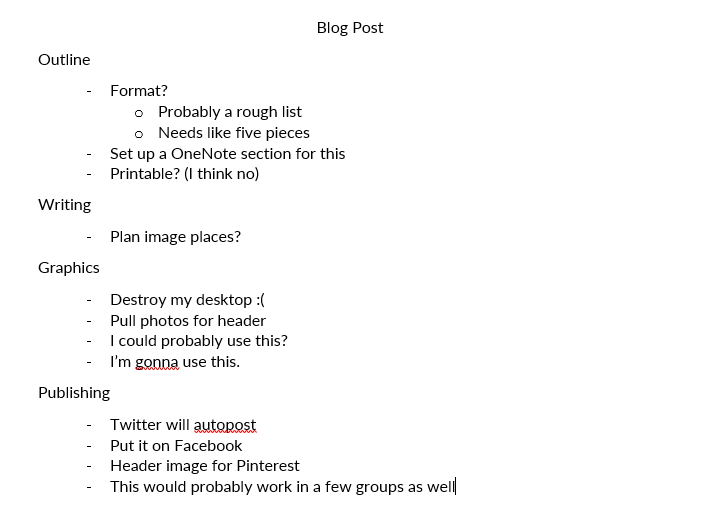I thought about making a listicle of, like, 25 tiny ideas like “make a list!” and “eat a healthy snack!” but… Why? The first thing that pops into my head is probably the first thing that pops into your head, and so I’m going to guess those ideas don’t work, because you and I are both still struggling. In an effort to find a better way, I started looking at what drives motivation. (It’s possible I did this research to procrastinate on something I didn’t want to do, but that’s beside the point.)
Honestly, it’s as simple as this: you have to just do it anyway. Notice I said “simple,” not “easy.” It’s not a complicated concept, but it’s hard to act on.
Remember all that research? From what I can understand, it all comes down to momentum. Your work has inertia – if you’re stagnated, it’s hard to get moving, but once you’ve got some momentum going, you’ll be able to tackle harder problems. Every time you accomplish something, your brain rewards you with a hit of sweet, sweet dopamine – a feel good chemical – that makes it easier to keep going.
That’s what every hack on this list is designed to do. These 5-minute fixes aren’t hard, but they do let you feel a little accomplished and productive. Which makes it easier to start on a larger, more intimidating project just a few minutes later.
5-Minute Fixes to Get Past “I Don’t Feel Like It”

De-clutter your space
We’re not talking all-out spring cleaning, here, so no worries. But your environment does have a huge impact on your thoughts. I’ve always suspected this, but a few minutes on Google proves the theory. Cluttered spaces make people feel overwhelmed and stressed, which doesn’t bode well for productivity. So to jump-start your momentum, take aim at some clutter you can see from your workspace.
The goal here is to make sure every horizontal surface in your workspace is mostly clear. Depending on where you work, that might mean clearing a desk, table, dresser, or counter. It could include putting all the laundry in the hamper. You might have to take some dishes to the kitchen. If you have important stuff – like bills or other mail – that needs to be dealt with, don’t worry about doing it now. Just sort it into three neat piles – high priority, mid priority, and low priority – and choose a time to do it later.
When you clear your space like this, you’re helping to clear your mind as well. You’ll be able to focus on the task at hand better, and that jump-start in productivity will help you dig into your work, even if it’s unpleasant.
Tackle digital overwhelm
Much like physical clutter, your computer or phone can be full of errant stuff, too. Digital clutter is anything from a desktop crowded with files to an overflowing email inbox.
I’m definitely bad at keeping my inbox under control, so whenever I need to start on a hard task, I’ll go through and handle a page or two of emails. Anything I can see that needs my immediate attention gets a star, anything I’ve taken care of gets archived, and all the junk gets deleted. Normally, I wouldn’t consider myself “stressed” about my emails, but cutting down on the backlog always feels like taking a load off my shoulders.
As for your desktop, well – I’m guilty of saving everything to the desktop so it’s easy to find, too. But then your desktop starts looking like this:

I did this on purpose and it was PHYSICALLY PAINFUL so you’re welcome.
There’s nothing “easy” about finding stuff in that mess. Sort those files into their proper folders – and if there’s not a proper folder for something, make one. Not only will this actually help you find stuff later, it’s another way of clearing your mind and cutting down on all that background stress you didn’t realize you were carrying.
Knock Out Some Two-Minute Tasks
David Allen – who’s a big name productivity consultant – has something called the “Two Minute Rule” where, if something takes less than two minutes, you do it immediately.
I think we’re all guilty of putting off tiny, important things: replying to emails, loading the dishwasher, returning phone calls, whatever. It’s so easy, too. The you of right now is kind of lazy. You don’t really want to do the thing. But we idealize our future selves as being so much more responsible. “It’ll be much easier to reply to these emails after I’ve gotten home from class/eaten some dinner/gotten a decent night’s sleep” – and then you wake up the next morning thinking the same thing.
I’d be money that, reading this, you can think of one or two little things that have been sitting at the top of your “to-do” list, gathering dust, for longer than you’d like. Go do them! Like clutter and digital overwhelm, these two minute tasks cause a lot of background stress. We can ignore it for the most part, but it feel amazing to be relieved of it. Think of it as the mental equivalent of accidentally popping your back – you didn’t know you needed to until you’d already done it.
Completing a few small tasks with a big mental payoff is a great way to jumpstart your motivation to do other things.
Divide and Conquer
Tackling a huge project is always daunting, but when you’re not into it, it’s somehow worse. Actually making a solid, step-by-step plan is a great way to prime yourself for the project. Not only will it help you plan, but seeing that completed plan is so satisfying.
Before starting, break your project into smaller tasks, group those tasks together, and decide on an efficient order to complete them. We all know, objectively, that planning things in advance is helpful. But when faced with unpleasant tasks, we feel so annoyed and listless that good form isn’t always a priority.
Grab a clean sheet of paper, an open Word doc, or a bullet journal page, mentally go through the project step by step, and braindump everything you need to do. No worries about making it pretty, just get it on a page. Then break your tasks down into similar groups that you can complete at once. For example, if you need to download a bunch of files to work on a project, download all the files at once, organizing them as you go. “Batching” your tasks like this will make you much more efficient, but also breaks your project down into manageable, bite-sized chunks. I braindump in Word before I write:

Depending on the size of the project, these groups can also be great for scheduling. Plan your breaks for between groups whenever possible, so you stay focused on one thing at a time. (The evils of multitasking are a whole other post, so suffice to say – focus on doing one thing well, then another thing well, then another thing well, rather than three things are the same time, but poorly.)
Reading Blog Posts Can Only Take You So Far
Seriously. Reading about productivity on the internet is satisfying because it gives the illusion of being productive, without actually requiring any work. Don’t fall into this trap. I could give you a bunch of empty platitudes how “everything worth having is worth working for” or “not trusting anything that comes without work” but those are just pretty words.
It’s like I said at the beginning. It’s not easy, but it’s simple: just start. And that same advice applies to these hacks, too. Reading them was great, I’m hoping you feel a little more prepared to tackle the stuff you’ve been putting off. But it means exactly nothing if you don’t use these ideas.
So here’s my challenge to the LBTL community:


